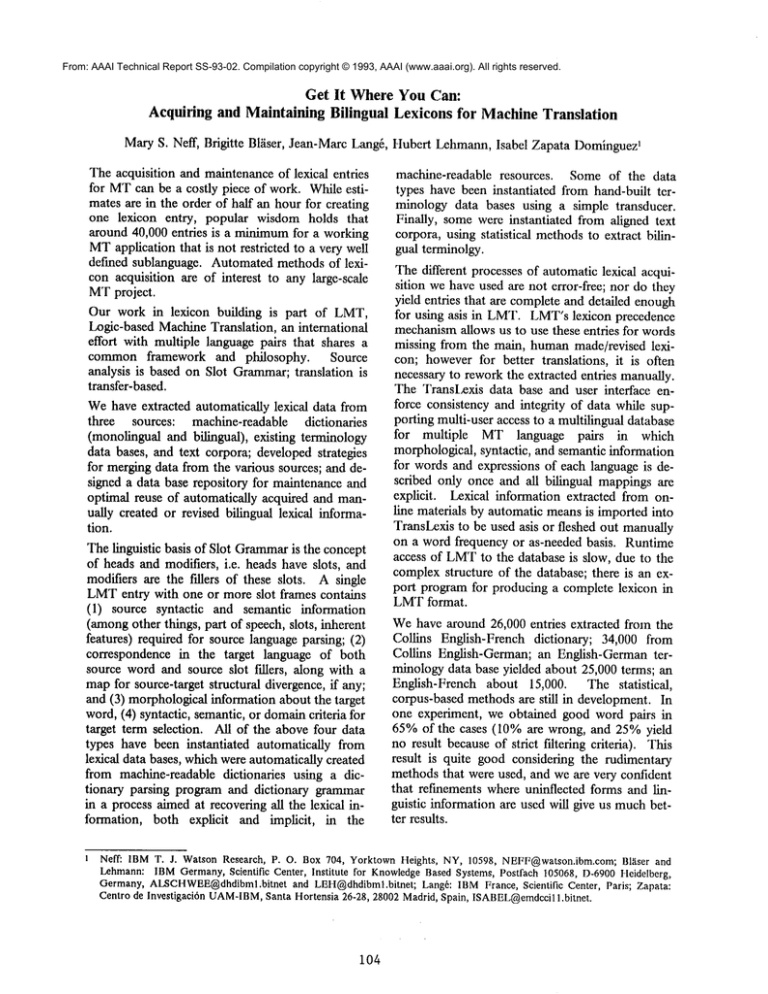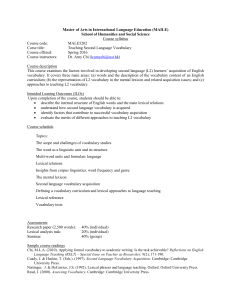
From: AAAI Technical Report SS-93-02. Compilation copyright © 1993, AAAI (www.aaai.org). All rights reserved.
Acquiring
Get It Where You Can:
and Maintaining Bilingual
Lexicons for Machine Translation
1Mary S. Neff, Brigitte
Bl~iser, Jean-Marc Langr, Hubert Lehinann, Isabel Zapata Dominguez
The acquisition and maintenance of lexical entries
for MTcan be a costly piece of work. While estimates are in the order of half an hour for creating
one lexicon entry, popular wisdom holds that
around 40,000 entries is a minimumfor a working
MTapplication that is not restricted to a very well
defined sublanguage. Automated methods of lexicon acquisition are of interest to any large-scale
MTproject.
Our work in lexicon building is part of LMT,
Logic-based Machine Translation, an international
effort with multiple language pairs that shares a
common framework and philosophy.
Source
analysis is based on Slot Grammar;translation is
transfer-based.
Wehave extracted automatically lexical data from
three sources: machine-readable dictionaries
(monolingual and bilingual), existing terminology
data bases, and text corpora; developed strategies
for merging data from the various sources; and designed a data base repository for maintenance and
optimal reuse of automatically acquired and manually created or revised bilingual lexical information.
The linguistic basis of Slot Grammaris the concept
of heads and modifiers, i.e. heads have slots, and
modifiers are the fillers of these slots. A single
LMTentry with one or more slot frames contains
(1) source syntactic and semantic information
(amongother things, part of speech, slots, inherent
features) required for source language parsing; (2)
correspondence in the target language of both
source word and source slot Idlers, along with a
map for source-target structural divergence, if any;
and (3) morphological information about the target
word, (4) syntactic, semantic, or domaincriteria for
target term selection. All of the above four data
types have been instantiated
automatically from
lexical data bases, which were automatically created
from machine-readable dictionaries
using a dictionary parsing program and dictionary grammar
in a process aimed at recovering all the lexical information, both explicit and implicit,
in the
machine-readable
resources.
Some of the data
types have been instantiated from hand-built terminology data bases using a simple transducer.
Finally, some were instantiated from aligned text
corpora, using statistical methodsto extract bilingual terminolgy.
The different processes of automatic lexical acquisition we have used are not error-free; nor do they
yield entries that are complete and detailed enough
for using asis in LMT. LMT’s lexicon precedence
mechanismallows us to use these entries for words
missing from the main, human made/revised lexicon; however for better translations,
it is often
necessary to rework the extracted entries manually.
The Transbexis data base and user interface enforce consistency and integrity of data while supporting multi-user access to a multilingual database
for multiple
MT language pairs
in which
morphological, syntactic, and semantic information
for words and expressions of each language is described only once and all bilingual mappings are
explicit. Lexical information extracted from online materials by automatic means is imported into
TransLexis to be used asis or fleshed out manually
on a word frequency or as-needed basis. Runtime
access of LMTto the database is slow, due to the
complex structure of the database; there is an export program for producing a complete lexicon in
LMT format.
Wehave around 26,000 entries extracted from the
Collins English-French dictionary; 34,000 from
Collins English-German; an English-German terminology data base yielded about 25,000 terms; an
English-French about 15,000. The statistical,
corpus-based methods are still in development. In
one experiment, we obtained good word pairs in
65% of the cases (10% are wrong, and 25% yield
no result because of strict faltering criteria). This
result is quite good considering the rudimentary
methods that were used, and we are very confident
that refinements where uninflected forms and linguistic information are used will give us muchbetter results.
Neff: IBM T. J. Watson Research, P. O. Box 704, Yorktown Heights, NY, 10598, NEFF@watson.ibm.com; Bl,~tser
and
Lehmann: IBMGermany, Scientific
Center, Institute
for Knowledge Based Systems, Postfach 105068, D-6900 Heidelberg,
Germany, Al-SCHWEE@dhdibml.bitnet and LEH@dhdibml.bitnet; Langr: IBM France, Scientific
Center, Paris; Zapata:
Centro de Investigacirn
UAM-IBM,Santa Hortensia 26-28, 28002 Madrid, Spain, ISABEL@emdccill.bitnet.
104






